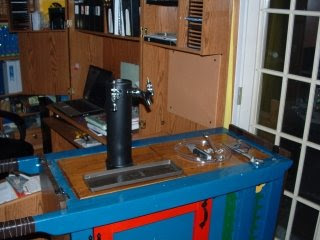Tonight, we did a tasting of three of my brews: a Northern English Brown, a Russian White Mead, and an Unoaked Merlot. Tasters were: my Lady Wife and myself.

First up: the Brown Ale. This poured from the tap with a moderate white head. (The first pint of the night had a perfect, 3/4-inch head.) The head dissipated within a few minutes, leaving a nice lace, and a ring of foam that chased the top of the beer down the glass. The aroma is of malt and fruity esters, perhaps a bit heavy on the fruit if anything. Visually, the beer is crystal-clear and a light amber-brown in color. The flavor mimics the aroma, with a nice malt forwardness balanced by the hop bitterness and some esters. It’s a touch over-carbonated right now, so tastes a little thinner than it ought; the CO2 also adds a bite from the carbonic acid that really shouldn’t be there. (Oh, the problems of not having independent regulators for the kegs…) It finishes rich, but a little dry. In all, a pleasant brew.
Second: the Russian White Mead. This is the third tasting of this mead; it’s been in the bottle for nearly a year, now. It is scheduled for two more tastings, unless the next one shows vast improvement. This mead is hopped, which changes its aging characteristics drastically, compared to my ‘usual’ brews. It pours smoothly, with perhaps a bit of carbonation; the second glass had some bubbles in the glass, which may have been the result of agitation from the first pour. These dissipated quickly, and were not a factor in the taste. The color is a light gold, comparable to a lightish Chardonnay. Aroma and taste-wise, it is smooth, and not unlike a decent white; there’s a backbone to it which is reminiscent of oak tannins, but not quite the same. Some oak would, in fact, probably benefit this mead immensely. It is definitely a dry mead, but not obtrusively so–it doesn’t suck the water from your mouth like some white wines do. Well-balanced. I would call this good for the white wine drinker who’s looking for something a little off the beaten path. Tasty, but my Lady Wife is put off by the ‘grassiness’ of the hops (which, to be fair, she tastes in nearly anything with hops in it).
Finally for tonight’s tasting, the Merlot. Pours a deep garnet red. No carbonation, which is as it should be. The aroma is fruity and rich, promising a luscious richness. There is a backbone of oak and, yes, mineral, present, but it doesn’t overshadow the sweetness, merely supports it. The flavor is all dark fruit and rich grape, again with the tannin support. It starts sweet and floral, and ends richly; the ‘middle’ leaves a little to be desired. There’s a certain undefinable quality about it that says that it needs something. I had been aiming for the Georgian wines when I started this; it has the sweetness and mouthfeel, but lacks the spiciness and crispness of the Georgian reds. I believe a blend would do wonderfully to remedy this–perhaps 70%/30% Merlot/Gewurztraminer. I believe this one is ready to serve, and will age beautifully over the coming months (years?).
For the curious, the Brown Ale was batch #60 in Misha’s Little Black Book:
Northern English Brown Ale
5 lbs Maris Otter pale malt
4.75 lbs Pale 2-row malt
.75 lb Special Roast malt
.5 lb Victory malt
.5 lb Crystal 40L
.25 lb Pale Chocolate Malt
1.2 oz Kent Goldings pellet hops (5%AA, 60 minutes)
1 Whirlfloc tablet (15 minutes)
.5 oz Kent Goldings pellet hops (5%AA, 5 minutes)
2 packets Nottingham Ale dry yeast
Mash at 152 degrees F for 1 hour. Sparge to 7.5 gallons. Boil 1 hour, hopping as scheduled. OG: 1.053.



